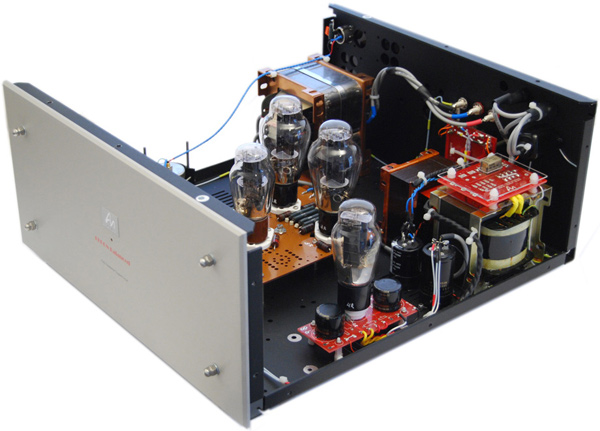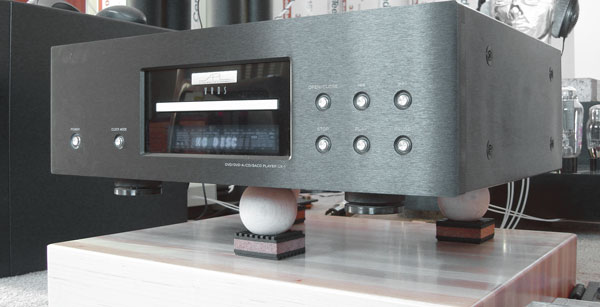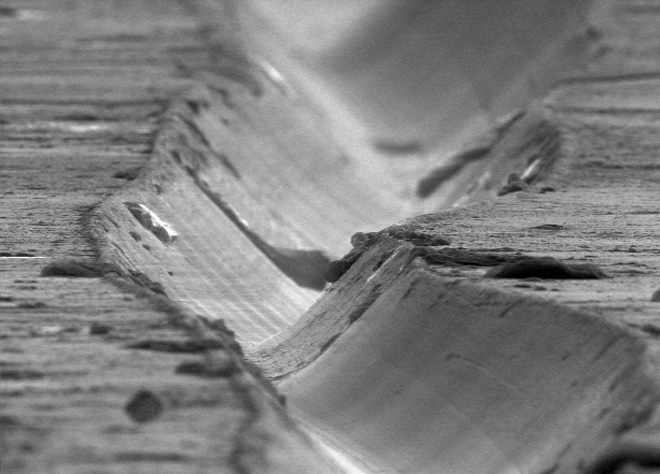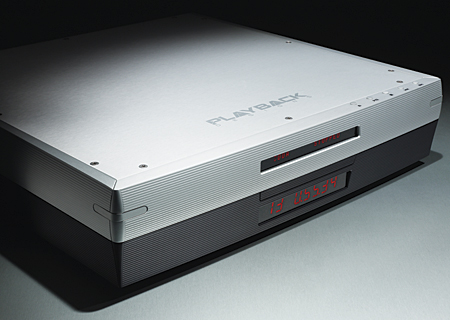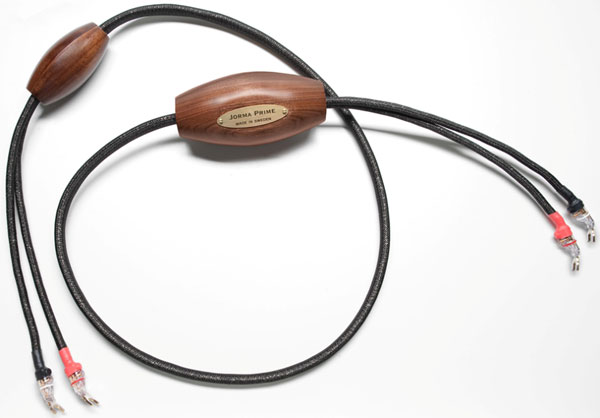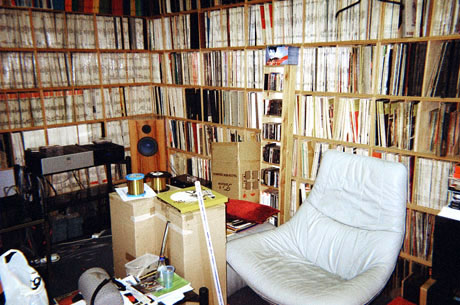
من Audio Note UK انگلیس رو خیلی دوست دارم و فکر نمیکنم Audio Note JP ژاپن چیز خیلی بهتری باشه چون صدایی که از Ankoru شنیدم واقعا بی نظیر بود.
من Audio Note ژاپن رو هم با الگزاندریا شنیدم اما شرایط دمو خوب نبود و اون آمپ بیچاره داشت زیر فشار الگزاندریا له میشد. برای درآوردن صدای یک لامپ (منظورم آمپلی فایرهای لامپی کم توان درست حسابی هست و منظورم گنده هاشون مثل Audio Research 610 نیست) قبل از هر چیزی باید یک بلندگو با حساسیت بالای 94 و امپدانس خطی نزدیک 8 پیدا کنید.
درسته ویلسون الگزاندریا حساسیتش بالای 90 هست اما امپدانس خیلی ناهموار و پایینی داره و عملا نمیشه باهاش لامپ شنید اونم با موسیقی هایی که تو فرکانسهای پایین انرژی زیادی دارند.
یک چیز رو بگم، من ممکنه خبری رو به پست قبلی “چند خبر” اضافه کنم چون نمیشه برای هر خبری یک پست جدید بگذارم ، کلا خوشم نمیاد پست زیاد کنم و اگر دیدید چند روزی سایت خیلی پست جدید توش نبود به یکی دوتا مطلب قبلی اش سری بزنید ممکنه مطالبی رو بهش اضافه کرده باشم.
سایت dagogo (باید با وی –پی–ان ببینیدش) یک گزارش از کمپانی AN گذاشته که جالبه :
Strange, how sometimes things that are the least anticipated are ultimately the most enjoyable. I had occasion to travel to London on business in August and decided to try to contact Peter Qvortrup in hopes that he might have time for dinner at the hotel where I was staying, a 150-year-old former manor house on Richmond Hill overlooking the Thames.
The current chef was rumored to have come from a well known Michelin starred restaurant, so dinner seemed to be a good idea. Given Peter’s busy schedule and international travel, I did not hold out much hope that he would be available. As it turned out, he responded almost immediately, suggesting that he pick me up on Sunday morning at my hotel to give me a factory tour followed by a listening session at his office. At some point, he felt certain that we could intersperse a meal.
On Sunday morning, Peter drove up in a vintage black Mercedes SL500, one of a number of Mercedes which he owns. From the hotel we spent the next hour driving to the factory, the first of what was to be a day of many surprises. I am not sure what I was expecting, perhaps a Porsche-like factory where the floor was clean enough to eat. The reality was a small, very well maintained, one-story white building in an industrial park surrounded by a formidable wrought iron fence. The building has about 4500 square feet of useable space that must provide room for storage, manufacturing, shipping and accounting. Every inch of space is occupied by storage racks overflowing with chassis and other parts necessary to build the Audio Note products. Except with respect to Level Four and Five products, most others are built in small runs rather than on a one-off basis. Consequently, at any point in time, there may be five to ten of a model in various states of assembly.
The factory has recently moved production of its speakers to a factory in Austria to alleviate part of the space problem. The last room that we visited prior to leaving was the burn-in room where every piece of Audio Note equipment is subjected to lengthy burn-in, re-measurement and recalibration. At this point, we left the factory and drove to another location closer to his home where Peter maintains a separate office, listening room and storage for the more valuable parts used in assembly of Level Four and Five products.
After a short drive through residential areas, we stopped in front of a row of connected shop fronts which appear to have been constructed in the early part of the twentieth century. The most likely resident would probably be a small restaurant or perhaps a green grocer. Peter’s space is rather non-descript with no signage or other indication of what the building may hide. On opening the door, the first view is floor-to-ceiling record storage racks on both right and left interior walls, and as a wall separating the listening area from the actual office, which as you may have guessed, is very small and incredibly cluttered space with the detritus generated by running a business. On closer examination, one begins to realize the enormity of the record collection (of which this is only a part), its breadth and its depth. Think more collectible British vinyl than you have ever seen in one place including an almost complete set of Decca SXL 2000’s and 6000’s, mostly the original wide-band pressings; early EMI’s with the wheat colored label; Columbia SAX’s; early stereo DGG Tulips, British RCA’s and Mercury’s, Lyrita’s and many , many more.
The next stop was the basement vault. Think here the treasure cave from Ali Baba and the 40 Thieves. Neatly arranged on shelves were all the Level Five parts that go into the construction of very topmost AN equipment: Blackgate caps, hand built silver foil capacitors, spools of silver wire, silver wound transformers and last but certainly not least a separate room filled with vintage tubes. Again, not a few dozens but crates of 1950’s and 60’s Mullard, Telefunken and Siemens small signal tubes. Hundreds of Western Electric drivers and regulators and ultra-rare 211 output tubes. I asked Peter about this and received an interesting answer with respect to the need for such seemingly massive inventories of high cost parts.
Most businesses believe in “just in time” procurement that minimizes the cost of inventory. Peter’s answer was two-fold, 1) the need to guarantee an Audio Note customer that in the future their unit can always be re-tubed or parts replaced with exactly the same parts that were originally provided in the unit, and 2) the desire to guarantee that once a product is issued, it can be manufactured using the same parts throughout the entire product run even if that run is 15 to 20 years. That guarantees that the sound of a particular product will remain unchanged for its entire life whether bought today or in ten years.
I have purposely left the best until last, the equipment that we listened to, the music we heard and the sound. The system was relatively simple consisting of the M9 preamp/phonostage, a pair of 211 based Gakuons, a CDT 3 transport, a DAC 5 D/A converter, AN/SPe Signature speakers, SOTTO and SOGON interconnect, SPX speaker wire and custom stands for the speakers. The speakers were located in the front corners of the room, oriented to fire so that they crossed in front of the listener. Unfortunately, we did not have a turntable as Peter had loaned it out for the weekend prior to my contacting him. The M9 and DAC 5 had massive tube based power supplies, the AN/SPe speakers’ sizeable outboard, silver wired crossovers were sitting atop the much larger and heavier SOGON crossovers.. This was that most unusual of audio beasts, a complete system designed and manufactured by a single company, totally handmade, with at least one of the components having been marketed for twenty years with no changes in parts or design. For better or worse, this was one of those very rare moments when the manufacturer was completely responsible for the sound that was heard. He had even chosen the room.
The M9 was specifically designed to be a phono preamp to capitalize on a unique new design for lossless RIAA equalization whose accuracy is within a tolerance of less than 0.1 dB. The inputs and outputs are transformer coupled using oversized Level Five silver wired transformers using a core material with a high nickel content. The volume control is hand-built using the highest quality resistors. The outboard power supply is massive, essentially a single chassis version of the power supply used in the M10 with about 70% of its capabilities. The amps inputs use balanced symmetrical silver wire wound transformers. The signal path between the input transformer and the oversized output transformer is comprised of five parts and two tubes, including a NOS RCA 211 and a driver, a silver wound interstage coupling transformer and two resistors. About as simple as you can get but with a massively overbuilt tube power supply.
The DAC 5 is a non-oversampling design provided with a separate massive tubed power supply. It dispenses completely with the usual digital filters and is coupled to other components via silver wire wound transformers. When used in conjunction with the CDT-3 transport, the performance sounds utterly non-digital, effortless, liquid and unbelievably dynamic.
The speakers are not visually impressive except for the large outboard crossover, although the 8″ deep blue paper/hemp woofers are eye catching. You do notice that the speakers are heavy and non resonant. According to Peter, the walls are three quarters of an inch thick and well braced. What you cannot readily see is the attention to detail such as the almost fanatical matching of the drivers, or for that matter the depth of understanding of acoustic and electrical theory that goes into them, but you can hear the difference. When properly set up, utilizing the corners of the room, these speakers are able to energize a room in the bass in a manner that nothing short of a monstrously large horn can do, and this is not the over-damped one-note bass that many audiophiles think of as state-of-the-art. They are also capable of flat response well below 40 Hz but do have limitations in this area. Likewise, they have a smooth, extended top-end but are not in the league of the Acapella ion tweeter. They are however extremely coherent even when one sits in the near field where something like the larger Acapella needs a larger room for the drivers to properly blend.
And now, finally, to the sound of the system. My host’s taste in music is quite eclectic and the CD’s which we played reflected that, ranging from a Grieg piano concerto to Puscifier’s (no, I am not making this up) ” V is for Vagina”. Note that all material was standard redbook CD’s sourced from the local stores. With respect to the Grieg, the system had very believable image height and differentiated well between the height of the piano and other instruments. The string tone on violins was very natural. PRAT was good as was the integration between the upper and lower frequencies.
The next cut was ”MUD” from the album We Can’t All Be Zingers by Primus and “Slipknot” from Subliminal Verses using a track called “Pulse of the Maggots”, both of which could be characterized as very aggressive rock. Drums were very taut with excellent impact. Again, the top seemed extended and detailed without any bite or harshness. Most noticeable was the ability of the 8” driver to create pressure gradients within the listening room which were noted as momentary density changes in the air of the room. I have heard few large systems capable of doing this as effectively as these drivers when corner loaded. I should also note that the bass was not ”one note” or overblown. This system had no problem separating the bass lines.
We next listened to a series of male vocals and acoustic instruments including cuts by Michel Jones, Jacques Brel and Nils Lofgren. Male voice was excellent, particularly in capturing the expression of the singer. The vibrato on the soprano voice on parts of the Jacques Brel was absolutely superb, as was the acoustic guitar on the Nils Lofgren. We concluded the session with the track “Du Hast” from the Ramstein album Sehnsucht, which translates as longing, Nirvana’s Unplugged and Alice in Chains’ Unplugged.
In each case, the system played effortlessly, drawing every single detail from the CD but never sounding bright or edgy. While much of this is music that I would not have chosen, I found myself drawn into the music and my foot tapping. This is probably the best digital performance I have ever experienced. The sound was totally non-digital and effortless, unbelievably liquid and incredibly dynamic. Had I not known better, I would have been searching for the subwoofer. The power of the amp was more than necessary to drive the speakers to listening levels that were painful. Unlike many transistor amps, the Gakuons produced depth on the kick drum and other bass instruments. This experience has caused me to re-think what can be achieved in a small to medium sized room. With respect to recreating the gestalt of a musical performance (and here, I mean accurately conveying the emotional content/sense of involvement) in the typical European home, this is one of the best systems which I have heard.
Peter was also nice enough to play several tracks from an in-house CD which Peter had recorded with a comparison between an industry standard professional analog-to-digital recorder and the patented Audio Note analog-to-digital converter. The conversion in the newly patented unit is not done with either a Phillips or Sony chipset but with a unit built totally in-house with discrete parts. If the sound on the CD is representative of what Peter’s new technology can do, then the commercial unit should be a revelation.
مجله Dagogo گزارشات جالبی از نمایشگاه ها داره که بد نیست ببینید. این مجله در مورد آئودیو نت یک جمله تبلیغاتی داره میگه :
Money can’t buy happiness! But it can buy the Audio Note Kegon Balanced.
این آمپلی فایر آئودیو نت فقط دو تا Stage داره دقیقا مثل ویتوس 101 البته ASR هم تو طبقه Power فقط 2 stage داره و یک stage هم برای Pre که میشه کلا سه تا. همه این طراحان میدونند هرچقدر مسیر سیگنال کوتاه تر و سیستم ساده تر باشه بهتره.
تو تحلیل این آمپلی فایر میخونیم :
It became clear early in the listening that the number of watts specified for each of these amps was not an accurate indicator of how well a particular amp would perform into the load presented by the Triolons. Peter Qvortrup , the owner of AN UK, has stressed in the past that many high-power designs lack the dynamics of lower power, well designed amps because the higher power amps are unable to deliver their power with equal efficiency at all frequencies. He refers to this ability as “unrestricted linearity”. At no point after the initial break-in period was there ever any question that these amps had more than enough power to drive the Triolons at the levels at which I normally listen with no sign of clipping or reduced dynamics. Indeed, the KBs had better micro- and macro-dynamics than the two Edge solid-state behemoths.
و در ادامه برای کنترل ناحیه پایین میگه (دقت کنید بلندگوی دمو شده یک هورن هست نه یک بلندگوی بد درایو اندازه خرس) :
The KBs do an excellent job of controlling the bass of the Triolons, but do sound very different from high powered transistor amps. The bass of the KB is fuller, warmer, and carries more natural bloom, yet they also sound somewhat less damped. The KBs do an excellent job of differentiating drum heads, exhibiting a tonal richness and complexity, coupled with the ability to differentiate timbre, that is a hallmark of single-ended triodes. Their ability to control the transducer, particularly dynamic drivers, is one of their defining characteristics. By this, I mean their ability to start, rapidly accelerate, and stop the movement of the driver which translates into added clarity and temporal coherence. While there are transistor amps that can do this, almost all of them truncate decay and sound over damped.
Likewise, there are tube amps that get the decay right but soften the leading edge. The KBs are able to reproduce the leading edge without any truncation of the reverberant tail. On the Roger Waters CD Amused to Death, the third track begins rather quietly, then out of nowhere there is the sound of an ax hitting a block of wood. The effect, if properly reproduced, will literally cause the listener to jump. This requires an amp that has both excellent dynamic range and the ability to create a very well defined leading edge. The KBs in combination with the Triolons are explosive!
بعد در مورد میدرنج ببینید چه حرف باحالی زده vibrant warmth معنی این عبارت اینه ما فیدبک منفی نداریم که صدایی soft و Warm بدون میکرو دینامیک داشته باشیم :
The Kegon Balanced’s reproduction of human voice is superb in the way that it conveys nuance and emotion. The midrange and lower treble are particularly natural, rendering male voices with a vibrant warmth and richness that is seductive.
یک خبر دیگه هم بازدید از کمپانی آکوفیض هست برای کسانی که برخلاف من آکوفیض دوست دارند اینجا:
http://www.dagogo.com/View-Article.asp?hArticle=342
یک گزارش خیلی جالب هم از طراح بلغاری سورس دیجیتال APL ببینید آقای Alex Peychev که esoteric رو کامل modify کرده :
لینک زیر:
http://www.dagogo.com/View-Article.asp?hArticle=328
یک جمله هم در مورد ویتوس فرمودند :
چقدر خبر نوشتم، خسته شدم.
اینم شیار روی یک صفحه Vinyl از دید میکروسکوپ الکترونیکی از وبلاگ مارتن :
خبر دیگه در مورد سورس دیجیتال Play Back Design هست که طراحش Andreas Koch همونیه که تو EMM LAbs هم بوده ، صدای این سورس مثل Lavry کمی به سمت صدای حسی تر میره تا Real و شاید دلیلش تا حدی اینه که فیلتر دیجیتال این برند خیلی تو Time Domain پاسخ خوبی داره.
مایک هم سعی کرده از EMM Labs خودش در مقابل این سورس دفاع کنه چون تحلیل گر Positive Feedback گفته بود In every category of audio virtue, what the EMM Labs DCC2 SE/CDSD SE did extremely well, the MPS-5 did better و مایک هم جوابش رو اینجا داده بود :
http://www.audiofederation.com/blog/archives/478
چیزهایی هم استریو فایل نوشته :
http://www.stereophile.com/hirezplayers/playback_designs_mps-5_sacdcd_player/
آخرین خبر هم تحلیل مجله Dagogo از عشق من Jorma Prime هست :
http://www.dagogo.com/View-Article.asp?hArticle=652
اینطور مینویسه :
Jorma Design is a small Swedish company that manufactures loudspeaker cables and interconnects at a variety of price points. The Jorma cables utilize very high purity copper wire, non colored Teflon dielectric, WBT Nextgen silver connectors and in some instances Bybee Quantum Purifiers. All are handmade and evidence a level of fit and finish that would not be out of place in a top quality German automobile. The Prime interconnects and speaker wires are Jorma’s statement products. They were initially shown at the 2006 CES as part of a Swedish Statement System that also featured the Martin Coltrane Supreme speakers.
The Jorma Prime differ from other Jorma products in their use of 99.999999% pure copper,as a conductor, the use of the Bybee Slipstream Golden Quantum Purifiers encased in a non-resonant walnut enclosure, and in their geometry and shielding. The material used to separate the conductors is a special, ultra thin ceramic glass fiber. Inside the conductors are hundreds of these fibers. The conductors, tiny high purity copper or gold threads, are wound in parallel around these fibers. The conductor therefore forms a tube that has a thickness of 0.1 mm. As Jorma points out in their literature, a hollow tube would be even better but is not practical in normal use. These cables also employ sophisticated shielding which rejects radio frequency interference (RFI) and electromagnetic interference (EMI) and stabilizes the cables against vibration and microphonics. The shield is heavily braided, tin plated copper that works very effectively in conjunction with the special geometry conductors to reject incoming RFI and EMI.
In reviewing/listening to cables, it is natural for the ear to focus primarily on tonal balance, whether light or dark, ying or yang. To do this is to severely limit the comparison. A number of other aspects of the sound are equally impacted by the choice of cables: phase accuracy, leading edge, timing, dynamics, harmonics, distortion mechanisms, etc. Perhaps even more importantly, resolution. There is a common misconception that more detail means thinner, sharper or more intrusive in sonics while less detail might go hand in hand with a warmer, smoother sound. This is certainly not the case with Jorma Prime cables which are significantly more detailed than with other cables that I have tried, but at the same time warmer and more liquid than, say, Nordost Valhalla. The enhanced resolution is at all frequencies and not at some narrow band of frequencies that has been elevated.
I am always somewhat suspicious when another reviewer claims that the insertion of a single piece of interconnect transforms the sound of their system and that subsequent substitutions of the “magic cable” result in noticeable but less significant improvement. Nonetheless, I did start with a single piece of the Prime which I tried in various locations and then added one piece of interconnect at a time until all interconnects in the signal path were Prime. Separately, I inserted a single length of the Prime speaker wire into the system, then added additional pairs until the system was tri-wired with Prime speaker wire. In another listening session, I was able to compare the Prime against the Valhalla speaker wire and against the lower priced Jorma No. 1 speaker wire. While the results were predictable, they did suggest that when replacing cables in an existing system, there was a clear order in which cables should be replaced. The single most significant improvement came with replacing the speaker wire which was roughly equivalent in magnitude to changing all the interconnects in the signal path. Changing the interconnect from the source to the preamp also made a greater difference than changing the interconnect between the preamp and the amp, although each was dramatic. In a situation where the speakers benefit from bi-amping, replacing jumpers with a second run of Prime speaker wire was also clearly audible but less dramatic than the initial run to the speakers.
There is also an additive effect, particularly with respect to changing out all interconnects in the signal path as well as speaker wire so that the entire signal path from source to speaker is cabled with Prime. This is equal in impact to changing out the cabling from the preamp to the amp. I am tempted to say that any other wire in the signal path obscures to some degree what the Prime is doing. Given that the cost of changing out two pairs of interconnect is roughly equivalent to changing out the speaker wire, I would suggest beginning with the source to the preamp and changing that first, followed by the preamp to the amp, and then the speaker wire.
I compared the Prime to a number of other cables, including the William E. Low Reference, Audioquest Sky, Jorma No. 1 and Aural Symphonics. The comparison with Nordost Valhalla was quite telling. I have always had great respect for Valhalla’s speed, extreme bandwidth and detail/resolution but have shied away from using it in my system because of its tonal balance which has always seemed a bit thin and lacking in the midbass and a touch aggressive at the top. The Prime in comparison with Nordost Valhalla seems like an ideal mix of the Valhalla’s strengths, but with more body, a better foundation in the lower frequencies and an extended, but less aggressive top-end. The Jorma retains all the air and sparkle of the Nordost but with increased resolution and enhanced leading edge definition. They are more musical, more dynamic and quieter. By quieter, I mean that sounds emerge from a blacker background.
I have noticed that “blacker background”, particularly with respect to power cords, often means that all low-level sounds whether musical detail or noise are equally attenuated, so that the end result is less resolution which often manifests itself as a loss of ambience and low-level detail. In other words, the loss of those things which tend to make a performance sound more like a live event. In the case of the Primes, the attenuation of EMI/RFI is not at the expense of the loss of musical information. The Primes are by a considerable degree the most resolving cables that I have used. By the same measure, they are also the lowest in noise. Dynamic shading is also considerably better on the Primes. This is particularly evident at the soft end of the spectrum. Bass has more power without being overblown. The Prime also does an excellent job of capturing the sound of struck instruments, favoring neither the initial strike nor the reverberant tail. Voices are more real, more fully fleshed out and contain more of those subtle details that suggest to the brain that you are listening to a live performer in a reverberant space. Lyrics are easily intelligible.
In comparison to the Aural Symphonics Chronos, the Prime was voiced differently. The Jorma has a natural warmth and richness in the upper bass through the lower treble that gives a very realistic body to stringed instruments. Struck instruments have both air and articulation. Size and placement of instruments on the stage is quite believable. The Jorma is virtually perfect in the midrange. Struck bells have somewhat more presence on the Aural Symphonics but suffer from a slight thinness not present with the Jorma. While the Aural Symphonics does an excellent job of separating the voices in a massed choir, the Jorma is equally discerning but again richer and somewhat better at catching the interplay of different voices, and more emotionally revealing. The AS is equal to the Jorma in recreating ambience but has a slight edge or bite, actually more of a brass-like sheen. The reedy sound of a saxophone is a touch more prevalent on the AS than the Jorma.
With respect to the William E. Low (Audioquest) Reference versus the Prime, the Audioquest has a more prominent upper bass/lower midrange. This is particularly evident in the sound of a bow drawn across the strings of a violin, viola or cello. The Prime has significantly better leading edge definition and is much faster, with the AQ sounding a bit slow and soft in comparison. Staging and depth are very natural on both. To the extent that the AQ has a weakness in comparison to the Jorma, it is in ambience retrieval and top-end extension. In particular, the top-end of the WEL is comparatively soft or rolled off. The resulting sound is euphonic and less accurate subjectively.
Conclusion
The Prime provides a level of resolution, refinement and clarity that in my experience embarrasses every other cable which I have tried in my system. This, combined with a natural warmth and richness in the upper bass through the lower treble, gives a very realistic body to stringed instruments and voices. It has an ability to convey the richness and warmth of live, unamplified music without sacrificing detail or articulation. Percussion is also very well served, preserving leading edge but not at the expense of truncating the reverberant tail. Size and placement of instruments on the stage is quite believable. The stage created has nice width and depth perspective. Depth is layered. Image focus and edge definition are again excellent.
These parameters are also extremely software dependent. The cable itself does not seem to impose a particular acoustic on the music played. Instead, the nature of the piece of music, the recording venue and the manner in which it was recorded dictate the size of the stage. An orchestra performing a large scale work will occupy the full width of my room extending far to the outside of the speakers, and depth will seem to push the back wall into the yard. With respect to more intimate works, the stage will appear much smaller. Not every CD or record has an expansive stage or incredible depth. In general, well recorded instruments are surrounded by a blanket of air and appear three-dimensional with believable body cavities.
This is a cable that gets the midrange right. Baritone, as well as massed female voices, are well served. If this cable sacrifices anything, it may be some extension in the top most octave; however, the cables with which I am familiar that have a bit more extension at the top are also plagued by various amounts of what I would term a metallic shade. Likewise, it may exhibit slightly less power in the lowest octaves than some competing cables although this is not really a lack of extension. In my system, I find the Jorma Prime’s reproduction of the bottom two octaves to be almost perfect. The Primes are more musically “right”, more truthful and less fatiguing than any competing product with which I am familiar, and infuse musical performances with a degree of liveliness and energy that suggests the real thing.
This cable also handles dynamics well. It can play loud, but more importantly given its low noise floor, it does an excellent job of differentiating shifts in volume at the softest end of the dynamic spectrum. To the extent that the Primes have a negative, it is clearly the elevated price. While the Primes are expensive, they sound better than most, if not all, cables that cost even more—sometimes significantly more. Not surprisingly, Jorma’s less expensive cables bear an unmistakable family resemblance to the Prime, and stand in a similar relation to the competition.
Postscript
Shortly after I had finished the initial review of the Jorma Prime interconnect and speaker wire, Dan Meinwald, the importer, contacted me to let me know that Jorma had a new Prime product. My initial response was of dismay, thinking that the months spent listening might be invalidated by a new Prime product. As it turned out, the “new” product was an AC power cord which supplements the existing cables, and resembles the interconnets.
I immediately launched into a series of listening sessions, comparing the Prime power cord against others that I have on hand: First those which do not incorporate Bybee technology, such as the Nordost Valhalla and Isoclean, then switching to cords which did incorporate Bybee modules, such as the latest Tweek Geek (incorporating ebony encased Bybees and plugs) and Bybee’s own cables (various versions all using the latest SE technology). While I have no desire to bore you with extended comparisons, I can say that on instruments like the saxophone and double bass, their sound with the Prime AC was more detailed, more resonant, and more tonally and harmonically complex. As one listener commented, the sax was more expressive and did a much better job of conveying rhythm and emotion. Voices were also particularly well served.
In comparison to the best of the cords incorporating Bybee SE modules, the Primes had more presence and detail, somewhat less bass (particularly with respect to the Tweek Geek cords) but much better control in the bass. Most importantly, the Prime AC gets the midrange right. It also handles dynamics well and has an extremely low noise floor.
Not surprisingly, the Jorma Prime AC cord is consistent in approach to their interconnects and speaker wire and enhances their effectiveness.
